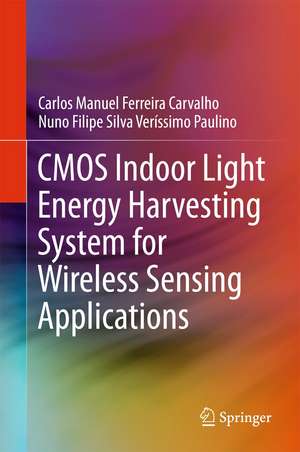CMOS Indoor Light Energy Harvesting System for Wireless Sensing Applications
Autor Carlos Manuel Ferreira Carvalho, Nuno Filipe Silva Veríssimo Paulinoen Limba Engleză Hardback – 10 aug 2015
| Toate formatele și edițiile | Preț | Express |
|---|---|---|
| Paperback (1) | 384.48 lei 6-8 săpt. | |
| Springer International Publishing – 22 oct 2016 | 384.48 lei 6-8 săpt. | |
| Hardback (1) | 391.79 lei 6-8 săpt. | |
| Springer International Publishing – 10 aug 2015 | 391.79 lei 6-8 săpt. |
Preț: 391.79 lei
Nou
Puncte Express: 588
Preț estimativ în valută:
74.97€ • 78.48$ • 62.03£
74.97€ • 78.48$ • 62.03£
Carte tipărită la comandă
Livrare economică 05-19 aprilie
Preluare comenzi: 021 569.72.76
Specificații
ISBN-13: 9783319216164
ISBN-10: 3319216163
Pagini: 216
Ilustrații: XIV, 216 p. 145 illus., 74 illus. in color.
Dimensiuni: 155 x 235 x 20 mm
Greutate: 0.5 kg
Ediția:1st ed. 2016
Editura: Springer International Publishing
Colecția Springer
Locul publicării:Cham, Switzerland
ISBN-10: 3319216163
Pagini: 216
Ilustrații: XIV, 216 p. 145 illus., 74 illus. in color.
Dimensiuni: 155 x 235 x 20 mm
Greutate: 0.5 kg
Ediția:1st ed. 2016
Editura: Springer International Publishing
Colecția Springer
Locul publicării:Cham, Switzerland
Public țintă
ResearchCuprins
Introduction.- Energy Harvesting Electronic Systems.- Photovoltaic Cell Technologies.- Voltage Step-Up Circuits.- Proposed Energy Harvesting System.- Layout of the System.- Experimental Evaluation of the Prototype.- Conclusions and Future Perspectives.
Textul de pe ultima copertă
This book discusses in detail the CMOS implementation of energy harvesting. The authors describe an integrated, indoor light energy harvesting system, based on a controller circuit that dynamically and automatically adjusts its operation to meet the actual light circumstances of the environment where the system is placed. The system is intended to power a sensor node, enabling an autonomous wireless sensor network (WSN). Although designed to cope with indoor light levels, the system is also able to work with higher levels, making it an all-round light energy harvesting system. The discussion includes experimental data obtained from an integrated manufactured prototype, which in conjunction with a photovoltaic (PV) cell, serves as a proof of concept of the desired energy harvesting system.
· Discusses several energy sources which can be used to power energy harvesting systems and includes an overview of PV cell technologies
· Includes an introduction to voltage step-up circuits, with a special emphasis on switched-capacitors (SC) DC-DC voltage converters, energy storing devices and maximum power point tracking (MPPT) techniques
· Presents a complete design flow of an indoor light energy harvesting system designed and implemented in a CMOS technology
· Discusses several energy sources which can be used to power energy harvesting systems and includes an overview of PV cell technologies
· Includes an introduction to voltage step-up circuits, with a special emphasis on switched-capacitors (SC) DC-DC voltage converters, energy storing devices and maximum power point tracking (MPPT) techniques
· Presents a complete design flow of an indoor light energy harvesting system designed and implemented in a CMOS technology
Caracteristici
Discusses several energy sources which can be used to power energy harvesting systems and includes an overview of PV cell technologies Includes an introduction to voltage step-up circuits, with a special emphasis on switched-capacitors (SC) DC-DC voltage converters, energy storing devices and maximum power point tracking (MPPT) techniques Presents a complete design flow of an indoor light energy harvesting system designed and implemented in a CMOS technology Includes supplementary material: sn.pub/extras























